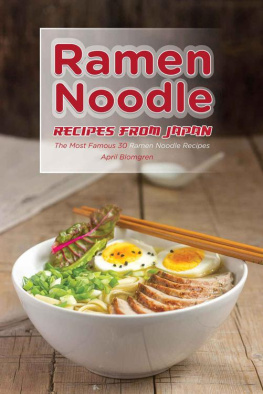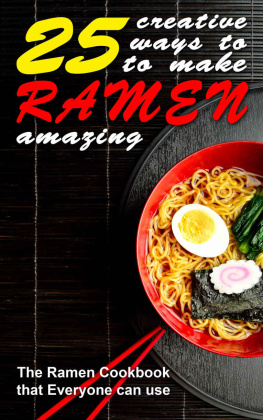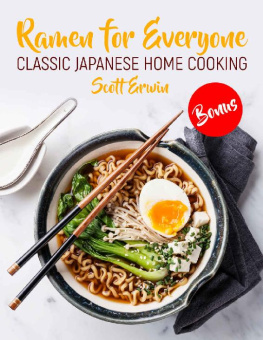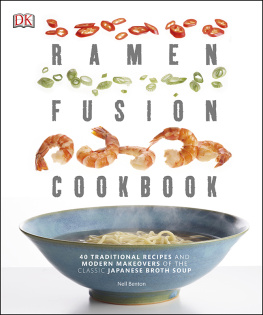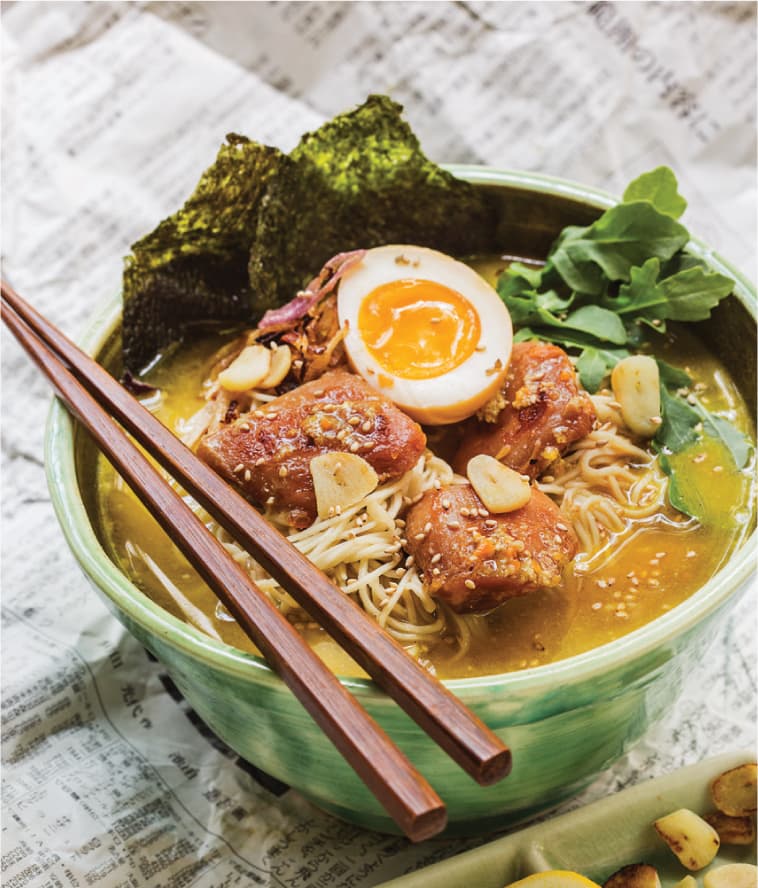Simply Ramen
A Complete Course in Preparing Ramen Meals at Home
Amy Kimoto-Kahn
Creator of easypeasyjapanesey.com


Text 2016 Amy Kimoto-Kahn
Photography (pp. ) 2016 Colin Cooke
First published in the United States of America in 2016 by
Race Point Publishing, a member of
Quarto Publishing Group USA Inc.
142 West 36th Street, 4th Floor
New York, NY 10018
www.quartoknows.com
All rights reserved. No part of this book may be reproduced in any form without written permission of the copyright owners. All images in this book have been reproduced with the knowledge and prior consent of the artists concerned, and no responsibility is accepted by producer, publisher, or printer for any infringement of copyright or otherwise, arising from the contents of this publication. Every effort has been made to ensure that credits accurately comply with information supplied.
We apologize for any inaccuracies that may have occurred and will resolve inaccurate or missing information in a subsequent reprinting of the book.
Digital edition: 978-1-62788-768-7
Hardcover edition: 978-1-63106-144-8
Names: Kimoto-Kahn, Amy, 1973- author.
Title: Simply ramen : a complete course in preparing Ramen meals at home / by Amy Kimoto-Kahn.
Description: New York, New York : Race Point Publishing, a member of Quarto Publishing Group USA Inc., [2015] | Includes index.
Identifiers: LCCN 2015034328 | ISBN 9781627887687 (hardcover)
Subjects: LCSH: Ramen. | Make-ahead cooking. | LCGFT: Cookbooks.
Classification: LCC TX809.N65 K565 2015 | DDC 641.82/2--dc23 LC record available at
http://lccn.loc.gov/2015034328
Editorial Director: Jeannine Dillon
Managing Editor: Erin Canning
Art Director and Cover Design: Heidi North
Food Photography: Colin Cooke
Food Stylist: Glynis Cotton
Location Photography: Andi Hatch Photography
Contents
Guide
Preface

Anyone who knows me knows that I love food. When I was a kid, I used to pretend I had my own cooking show and would make mud pies decorated with flowers from the yard. I would set up a table and pretend there was a mirror above me (remember, thats how they used to show food on cooking shows?) and angle my creations at the camera for all to see. My sous chef would always be Ponch, from the show CHIPS. Why? Because he was a babe and who wouldnt want him as a sous chef? I continued this love of cooking in the real kitchen and my mom would show me all of her tricks, such as how to fold my fingers against the top of an onion when slicing and how to use my thumb to measure the water above the rice. Just above your first knuckle! she would say. And how to add a crumbled bouillon cube and a drizzle of sesame oil over steamed broccoli to give it flavor. Like all good Asian moms, whether or not we had a party for five or fifty, wed always have enough food to feed anyone who might happen to drop by.
As I grew up and the time came when I could afford my own super-sharp knives, I went down the career path that college prepared me for and continued working in marketing. Cooking was just a hobby, and I had no formal schooling in it; I just loved foodeating it and sharing it. My friends would say that I should open my own restaurant and my response was always that it would never happen because I didnt like to cook for strangers. I put so much effort and love into my cooking and I didnt know how I could share that with someone I didnt know.
The social-media boom hit and I was right in there, working with clients and making things happen for them, but on the side, I kept my little blog of my journey to one day fulfill the dream of having a cookbook, calling it easypeasyjapanesey. Then I decided to take myself a bit more seriously and hunted down an editor, Laurel Leigh. I say hunted because I literally found her name in a bunch of Williams-Sonoma cookbooks that I liked and cold-called her. I told her what I was thinking of doing and she said she wasnt sure why she felt compelled to work with me but that I could be her sort of pro-bono account. Just like that, I had an editor. Slow-forward five years and we finished a proposal to submit to a publisher. She felt it was time to introduce me to Leslie Jonath, a wonderful book packager with Connected Dots Media. Leslies contacts then led me to Race Point, my publisher, and to Jan Newberry, a wicked good editor who helped keep me on the right track.
When Jeannine Dillon, my editor at Race Point, asked me if I would do a cookbook on ramen, honestly, my first thought was, I dont know if I can do this. Ramen, now that aint easypeasyjapanesey... thats huge. Then my husband, Dave, encouraged me to go for it. He said he could hold us afloat for the year and that he would turn into Superdad with the kids to cover the evenings and weekends. The blessing in all of this is how much my kids just adore him. They all run to the door and give him a kings welcome every night he comes home from work, and my two-year-old daughter, Ellie, looks at him like hes just the best thing since mini marshmallows. Throughout the process, I struggled with having so many original-style recipes versus an entire cookbook of just traditional ramen soups. It went against the Japanese in me to work on so many things at once instead of concentrating on just a few.
Original-style ramen is a term used in Japan for ramen made with nontraditional ingredients. It wasnt until I went to Japan and met Tomaharu Shono, the owner of Mensho Ramen (and five other ramen-yas in Tokyo, as well as one in San Francisco), that I felt vindicated. Hes a top ramen chef and the master of original-style ramen. Hell often make limited-edition ramen that eager customers patiently line up for, knowing that when the soup runs out, its too bad, so sad. He uses ingredients such as foie gras and soy milk; spices such as cinnamon, cumin, and fennel; and even makes a chocolate noodle. He told me that there are no rules to original-style ramen, just as long as you show integrity in how you pull it all together. I showed him some of my recipes and he gave me a thumbs-up. I couldnt wait to get home and get my creative cooking juices flowing.
Amy Kimoto-Kahn
Introduction

I am a yonseia fourth-generation Japanese-American. Simply put, my great-grandparents on both sides were born in Japan and were the first in my family to move to America. My parents and grandparents were both interned to concentration camps during World War II. My Great Uncle Joe Fujimoto, on my moms side, fought in the 442ndthe only fighting unit in the U.S. Army composed entirely of those with Japanese ancestry, while their families were subject to internment. Crazy stuff. I grew up in Fullerton, California, with an older brother and sister in the heart of Orange County. Even though I went to Japanese school on Saturdays for over eight years and studied Japanese in college, I dont speak the language much, but thats pretty common among yonsei. I find it ironic that my parents were taken from their homes and put into camps because of their ethnicity when their generation was taught to be as American as they could be to fit inneither of my parents has any audible accent. They understood Japanese better than they could speak it, so the language wasnt often spoken in our home. I had never even been to Japan before I wrote this book.


